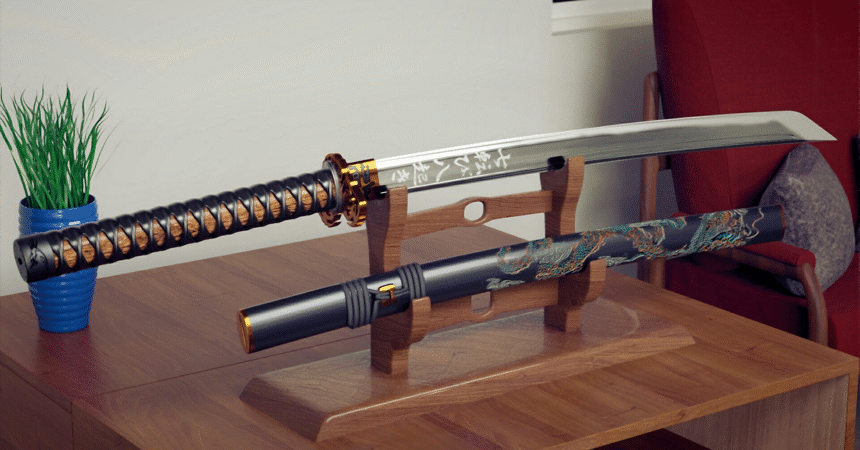Introduction
The Japanese sword has been used in history as more than a weapon. It is a mark of pride, bravery, and mastery that was the manner of the Samurai. Every blade has a legend that is inspirational to both enthusiasts and historians. We shall reveal a dozen great stories that demonstrate the splendor of these swords.
-
Dojigiri Yasutsuna
One of the five great swords in Japan, Dojigiri was a famous sword that was used to cut off the life of a demon called Shuten-doji. This tale transformed the sword as a weapon into a mythic thing associated with heroism and courage.
-
Masamune Honjo
The Tokugawa shogunate represented the Honjo Masamune. It was created by the legendary swordsmith Mara Masamune, and it stood for strength and peace. The Japanese sword has been used in history as more than a weapon. Its enigmatic disappearance following World War II makes it one of the greatest sword mysteries Masamune has never been able to solve.
-
Munechika Mikazuki
The crescent moon blade is appreciated due to the curved grain designs. It is said that its mmakerSanjo Munechika maker, Munechika, was aided by a spirit fox when forging it. This story brings out the religious relationship that exists between craftspeople and craft.
-
Kogarasu Maru
The Kogarasu Maru was unique in that it combined the older tachi and modern katana; Munechika, it was designed with the two-edged design. Its invention was an innovation in the production of swords, which gave samurai the motivation to learn new methods but not forget the old.
-
Juzumaru Tsunetsugu
This sword is associated with Buddhist monks and is supposed to be a symbol of prayer and fighting. Juzumaru (bead sword) was so named because of Buddhist prayer beads that were attached to it. This tale is a representation of peace between religion and power.
-
Odenta
There are legends of how Odenta could heal sickness in the Maeda clan. It was a popular Samurai method, but the Samurai sword, its wide blade, and the Samurai’s defense aura were more valued for their supposedly mystical talent than for their physical appearance. The Japanese sword has been used in history as more than a weapon
-
Shokudaikiri Mitsutada
The name of this sword is given because it was used to cut a candle, a stainless steel candlestick, in a duel. It demonstrates the acuity and strength of the master swordsmith Mitsutada. Nowadays, it is being grown into a war weapon and an art.
-
Fudo Kuniyuki
The Fudo Kuniyuki is identified with the popular general Date Masamune. It was allegedly a symbol of his hot-tempered character and stubborn soul. To Samurai, there was no difference between having such a sword in possession and possessing a part of their own character.
-
Ichigo Hitofuri
The only tachi-sized sword ever created by Awataguchi Yoshimitsu was Ichigo Hitofuri. It represented loyalty, ancestry, and prestige across generations and was an heirloom shared by the powerful clans.
-
Yamatorige
The Yamatorige lineage, Yamatorige, translated as “mountain bird feathers,” is also popular due to its flame designs along the blade. It was a status symbol and a divine blessing to warriors. It was a poetic masterpiece rather than a battle tool, owing to its design. The Japanese sword has been used in history as more than a weapon
-
Hotarumaru
Hotarumaru was known as having blazed with fireflies at night because of folklore. This light was reported to rejuvenate the “mountain bird feathers” blade, making it mystical and viable at the same time. Samurai held it as a protector sword of their souls.
-
Tsurumaru Kuninaga
This sword with a crane-motif blade was a symbol of long life and prosperity. It is admired because of its artistry as well as the message of hope, a motif that made warriors remember that even in a fight, beauty and peace might coexist.
FAQ’s
Q1: Why are these stories about Japanese swords important?
They preserve the samurai’s spiritual and cultural legacy, which consists of art, culture, and history.
Q2: Are those swords imagined or real?
Although most swords are historical artifacts, they frequently have mythological elements.
Q3: What distinguishes the Japanese sword?
It is distinct with its acuity, grace, and rich symbolism that make it different from other arms in history.
Conclusion
The Japanese sword is not just a piece of steel, but it is the soul of Samurai glory in art and legend. As stories of demon killing, peace, peace, and healing, in every case, we are shown how these blades gave courage and devotion. All twelve legends demonstrate that a sword was not merely a weapon; it had become a representation of honor, tradition, and eternal beauty.







